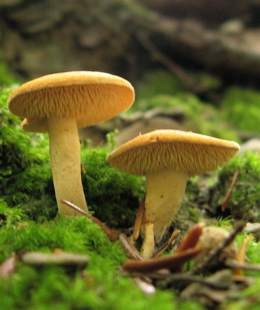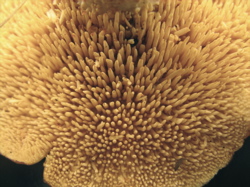Hydnum umbilicatum, the sweet tooth
 Known as both the “hedgehog” and the “sweet tooth” mushroom, Hydnum umbilicatum has some remarkable features that make it an incredible member of the diverse world of fungi. This mushroom gets its common names due to its edibility and the structure of its gills.
Known as both the “hedgehog” and the “sweet tooth” mushroom, Hydnum umbilicatum has some remarkable features that make it an incredible member of the diverse world of fungi. This mushroom gets its common names due to its edibility and the structure of its gills.
Hydnum umbilicatum is taxonomically classified as a member of the phylum Basidiomycota. This group is united by their basidia, the cells that produce spores. The basidia poke out from the surface of a hymenophore of one type or another. Most familiar mushrooms have a gilled hymenophore–on the faces of the gills the basidia are busy making lots and lots of spores. However, the Hedgehog mushroom has a tooth-like hymenophore, instead of gills underneath its cap. Hence, it is named after a particularly spiky creature.
The genus Hydnum is not just unique in its reproductive structures. It also known by its particular shape (or stature), its smooth white spores, and its mycorrhizal habit. Mycorrhizal activity means that the mushroom is involved in a mutually beneficial relationship with trees or plants. The two partners exchange nutrients with one another to sustain growth. In the case of Hydnum, the symbiosis is with oak trees and occasionally conifers.
These particular characteristics place the Sweet Tooth in the order Cantharellales, a group most famous for its star member, the chanterelle. The Hedgehog is related to both the orange and black chanterelles1 (Cantharellus and Craterellus spp.), which people find to be quite tasty. Although the chanterelles and tooth fungi look quite different, their similarities are surprising: both have white smooth spores and are mycorrhizal. They both taste sweet and have a lightly fruity odor. Lastly, and sometimes most importantly when looking to make a Cantharellales dinner, they are both fairly resistant to insects, although Hydnum seems to be even more so than the chanterelles.
 Given that H. umbilicatum is fairly bug-resistant, you may be delighted to also find out that the Sweet Tooth sounds just like it tastes: sweet and delicious! The species is reported to have a mild peppery taste as well, making it a prized edible. Another Hydnum species is also a culinary treasure: Hydnum repandum, which some know as the true Hedgehog mushroom, is larger but similar to its delicious sister. Both species fruit late in the season, around September or October here in upstate New York. Hydnum umbilicatum and H. repandum are both a toasty tan-orange, but the latter has a much bigger, broader cap, whereas the former typically has an “umbilicate” form–a little “innie” belly button in the center of the cap.
Given that H. umbilicatum is fairly bug-resistant, you may be delighted to also find out that the Sweet Tooth sounds just like it tastes: sweet and delicious! The species is reported to have a mild peppery taste as well, making it a prized edible. Another Hydnum species is also a culinary treasure: Hydnum repandum, which some know as the true Hedgehog mushroom, is larger but similar to its delicious sister. Both species fruit late in the season, around September or October here in upstate New York. Hydnum umbilicatum and H. repandum are both a toasty tan-orange, but the latter has a much bigger, broader cap, whereas the former typically has an “umbilicate” form–a little “innie” belly button in the center of the cap.
If it sounds too good to be true, it is. The Sweet Tooth does indeed have its shortcomings. As opposed to H. repandum, it is less sought after. Though delicious, the Sweet Tooth is smaller, and also much more sparsely distributed in its habitat than the Hedgehog, requiring a lot more time and effort to collect a full meal’s worth. Nevertheless, this mushroom still finds itself in a group of star edibles that are worth the hunt. The Sweet Tooth is easily identifiable, and it makes for a rewarding experience of finding and identifying a delicacy right in your backyard, on your very own.
- Pine, E. M., D. S. Hibbett, and M. J. Donoghue. 1999. Phylogenetic relationships of cantharelloid and clavarioid Homobasidiomycetes based on mitochondrial and nuclear rDNA sequences. Mycologia 91:944–963.
- Wood, M.Hydnum umbilicatum. California Fungi. MykoWeb.com
- Volk, T. Hydnum umbilicatum, the sweet tooth mushroom. Tom Volk’s Fungus of the Month for October 2004, TomVolkfungi.net.
Photos by K.T. Hodge.


More about these little brown hydnoids: Huhtinen & Ruotsalainen 2006: Variability of Hydnum rufescens in Finland: three taxa hidden under one name – and appearance? Karstenia 46: 17-24.
Thanks for your comment and reference, Seppo. It seems whenever mycologists look closely at a “species” we find multiple misunderstood mushrooms, who must be relieved to receive their very own names.
Yes, and I do have REAL, GENUINE reprints on thin sheets of wood decorated with a colourful mixture of various inks. But haven’t received a mailed with-a-nice-stamp -reprint request for ages… Anyone, eh ? Just for the old time’s sake ? Once in this century … : )
My backyard is full of mushrooms and I think I’ve identified some of these. Can’t wait to taste them – your images are spectacular.